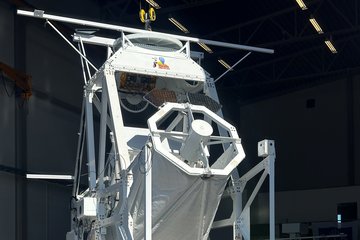All genres
221.
Journal Article
GREAT: a first light instrument for SOFIA. Proceedings of the SPIE 7014, 701410 (2008)
222.
Journal Article
Semiannual oscillations in the atmosphere of Mars. Geophysical Research Letters 35, L23202 (2008)
223.
Journal Article
An improved method for nonlinearity detection applied to a new 400-MHz bandwidth Chirp transform spectrometer. Transactions on Systems, Signals & Devices 3 (4), pp. 1 - 15 (2008)
224.
Journal Article
HHSMT observations of the Venusian mesospheric temperature, winds, and CO abundance around the MESSENGER flyby. Planetary and Space Science 56, pp. 1688 - 1695 (2008)
225.
Journal Article
Mesospheric vertical thermal structure and winds on Venus from HHSMT CO spectral-line observations. Planetary and Space Science 56, pp. 1368 - 1384 (2008)
226.
Journal Article
The quasi 5-day signal in the mesospheric water vapor concentration at high latitudes in 2003 - A comparison between observations at ALOMAR and calculations. Journal Geophysical Research 113, D04101 (2008)
227.
Journal Article
GREAT: the German first light heterodyne instrument for SOFIA. Proceedings of the SPIE 6678, 66780K (2007)
228.
Journal Article
Long-term trends of the concentration of the minor constituents in the mesosphere - a model study. Atmos. Chem. Phys. Discuss. 7, pp. 15453 - 15494 (2007)
229.
Journal Article
Remote sensing of a comet at millimeter and submillimeter wavelengths from an orbiting spacecraft. Planetary and Space Science 55, pp. 1050 - 1057 (2007)
230.
Journal Article
Middle atmosphere polar warmings on Mars: Simulations and study on the validation with submillimeter observations. Planetary and Space Science 55, pp. 1103 - 1112 (2007)
231.
Journal Article
Seasonal changes of the baroclinic wave activity in the northern hemisphere of Mars simulated with a GCM. Geophysical Research Letters 34, L09203 (2007)
232.
Journal Article
Small-scale temperature fluctuations associated with gravity waves cause additional radiative cooling of the mesopause region. Geophysical Research Letters 34, L24807 (2007)
233.
Journal Article
Winter polar warmings and the meridional transport on Mars simulated with a general circulation model. Icarus 186, pp. 97 - 110 (2007)
234.
Journal Article
On the winter anomaly of the night-to-day ratio of ozone in the middle to upper mesosphere in middle to high latitudes. Advances in Space Research 40, pp. 846 - 854 (2007)
235.
Journal Article
GREAT: the German first light heterodyne instrument for SOFIA. Proceedings of the SPIE 6275, 62750K (2006)
236.
Journal Article
MIRO: Microwave Instrument for Rosetta Orbiter. Space Science Reviews, pp. 561 - 597 (2006)
237.
Journal Article
Behaviour of mesospheric ozone under nearly polar night conditions. Advances in Space Research 38, pp. 2402 - 2406 (2006)
238.
Journal Article
The high resolution chirp transform spectrometer for the SOFIA-GREAT instrument. Experimental Astronomy 18, pp. 77 - 91 (2006)
239.
Journal Article
A Digital Dispersive Matching Network for SAW Devices in Chirp Transform Spectrometers. IEEE Trans. Microw. Theory Tech. 54 (4), pp. 1415 - 1424 (2006)
240.
Journal Article
Description and climatology of a new general circulation model of the Martian atmosphere. Journal Geophysical Research 110, E11008 (2005)











